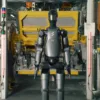Artificial intelligence has gone from hibernation to an explosion of innovation, from playing chess to creating 3D worlds. What's the next big breakthrough? Spatial intelligence, a technology that not only understands images, but also perceives, generates and acts in three-dimensional space. And this can be more disruptive than the language models we have become so accustomed to.
In recent years, we have witnessed a real boom in artificial intelligence (AI). From playing chess to generating text, there seems to be no limit that UI can't cross. But the real revolution comes with something that goes beyond just understanding language and images. It is at the heart of the next technological evolution spatial intelligence, the ability of UI to understand, create and move in three-dimensional space. Sound like science fiction? In fact, we are already on our way there.
How did we get here?
Let's start at the beginning: artificial intelligence has been in a kind of "winter" for a long time. But the last decade has brought incredible progress. A boom deep learning has allowed the UI to not only recognize objects in images, but can now also create them, from Van Gogh-style photographs to entirely new scenes. Right computer vision became one of the key areas of research that allowed UI to begin to understand and interpret the world as humans see it.
All this was just a preparation for what was to come: the transition to spatial intelligence.
What is spatial intelligence?
Spatial intelligence is the ability of artificial intelligence to perceive, understand and act in 3D space. It is the ability for UI not only to see the world as a flat image, but to perceive it as a three-dimensional structure. This means that it can recognize how objects and events are located in space, how they interact with each other, and how they might move or change over time. In short, the UI becomes a kind of digital "spatial" architect.
On the one hand, we have language models like GPT that excel at text processing and generation. Spatial intelligence, on the other hand, focuses on something completely different: understanding the physical world. While language is created by humans, the spatial world is there regardless of us. If AI can begin to understand space the way we do, we will reach a whole new level of technological development.

Why now?
Technologies such as Nerf (Neural Radiance Fields), developed by a team of top researchers including Ben Mildenhall, showed us that UI can recover 3D structure from 2D images. And it happens quickly – within hours on a single graphics card. This is no longer just a theoretical capability. The combination of advanced algorithms, massive amounts of data and tremendous computing power has created the perfect environment for an explosion of spatial intelligence.
How will this change our world?
The idea of being able to create entire 3D worlds naturally evokes associations with gaming or virtual reality. But the applicability of spatial intelligence is significantly broader. Imagine being able to use AI to generate an entire virtual world for education, architecture, medical simulation or even entertainment. By creating worlds so realistic that they are almost indistinguishable from reality, it could usher in a new medium where the lines between reality and the virtual world blur.
And that's just the beginning. Also augmented reality (AR) will be able to acquire completely new dimensions. Instead of just seeing virtual objects in your field of vision, these objects will understand the space around you, interact with it and even influence it. Think of it as AR on steroids. Your glasses will be able to show you how to fix your car, even if you have no idea about the mechanics - all in real time, tailored to your environment.
The next frontier: robots
If you think spatial intelligence stops at AR, you're wrong. The real breakthrough will be in the physical world, where they will be robots can take advantage of this technology to navigate and interact in a three-dimensional environment. From autonomous vehicles to robots in factories, the ability to understand 3D space will be key for any device that will operate outside of a controlled environment.
Conclusion
Spatial intelligence will not only be a new functionality in the world of UI, but a new era. In fact, this technology will set the stage for a future where the boundaries between the physical and digital worlds become almost invisible. It's not just about creating smarter algorithms, but about a fundamental change in how UI perceives and shapes the world around it.
Once AI understands space like we do, there will be no turning back.






